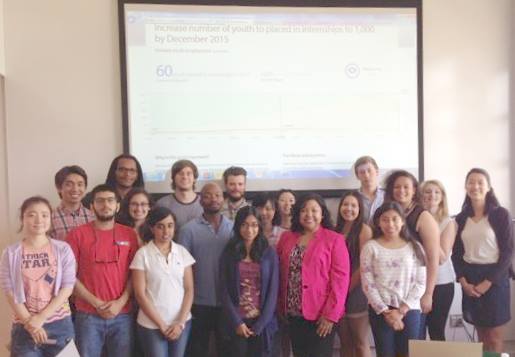To be clear, Tuesdays and Thursdays are the two days where project leads are expected to work with the whole team for the day. Likewise, Monday, Wednesday, Fridays are marked as individual work times, but my group usually works together quite a bit to make sure we're all on the same page with how to move forward, and historically we've had a lot of tutorials and presentations on these days. I'm not sure if I've ever mentioned that before, but maybe if you've been keeping up with this blog you've already noticed the pattern. Anyway, since today was a Thursday Anat was with us for most of the day and Valentina was there too, along with all the regulars.
After lots and lots of intense discussions this week, today was more of a work day where we went about on different tasks trying to implement some of the code and strategies we had talked about. Of course, as soon as you fingers hit the keyboard you realize other major flaws in the plan that we had not discussed yet, and then we would have to talk about how we were going to handle it, but for the most part we did actually get a good chance to make some coding and programmed progress. First off, we made some real headway with the routing formula that Frank, Kivan, and Rohan were checking out in different facets. Frank had some great ideas about creating a matrix with all the routing distances we would need to use so that we would only need to put in one request to OSM, which we hypothesize is going to be the step that takes the most time. Time is critical in our program because we want it to run in real time for the dispatchers to be able to reroute requests. This is why we've been working as hard as we can at each step to steer clear of computationally expensive solutions or algorithms that would take too long to output an answer. Right off the bat what comes to mind is how after talking with Anat, Kristen presented a great idea about switching the order of the feasibility steps so that the capacity check would come before the rerouting checks, since we believe the routing steps will be more computationally expensive and take longer to process. Kristen and I discussed it for quite some time talking about how it would need to be structured to work with the rest, and how we would need to change the other two routing checks (pickup and drop off insertions) to comply with this new code.
After lots and lots of intense discussions this week, today was more of a work day where we went about on different tasks trying to implement some of the code and strategies we had talked about. Of course, as soon as you fingers hit the keyboard you realize other major flaws in the plan that we had not discussed yet, and then we would have to talk about how we were going to handle it, but for the most part we did actually get a good chance to make some coding and programmed progress. First off, we made some real headway with the routing formula that Frank, Kivan, and Rohan were checking out in different facets. Frank had some great ideas about creating a matrix with all the routing distances we would need to use so that we would only need to put in one request to OSM, which we hypothesize is going to be the step that takes the most time. Time is critical in our program because we want it to run in real time for the dispatchers to be able to reroute requests. This is why we've been working as hard as we can at each step to steer clear of computationally expensive solutions or algorithms that would take too long to output an answer. Right off the bat what comes to mind is how after talking with Anat, Kristen presented a great idea about switching the order of the feasibility steps so that the capacity check would come before the rerouting checks, since we believe the routing steps will be more computationally expensive and take longer to process. Kristen and I discussed it for quite some time talking about how it would need to be structured to work with the rest, and how we would need to change the other two routing checks (pickup and drop off insertions) to comply with this new code.

 RSS Feed
RSS Feed